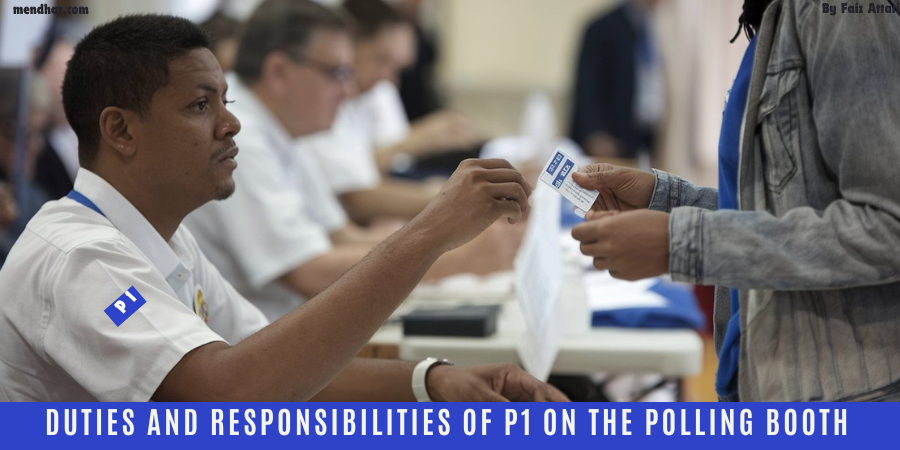Introduction:
In the context of Indian elections, the Election Commission of India (ECI) plays a crucial role in ensuring the smooth conduct of the electoral process. One of the key components of this process is the polling booth, where voters exercise their right to vote. The success of this process depends significantly on the roles and responsibilities assigned to the various personnel at the polling booth. Among these, the duties and assignment of P1 on the polling booth, the Presiding Officer, are of paramount importance, especially in EVM-based elections. The Presiding Officer, or P1, is responsible for managing the overall conduct of the election at the polling station, ensuring that every procedure is followed correctly and that the polling process is transparent, fair, and efficient.
Role of P1 in EVM-Based Elections
The duties and assignment of P1 on the polling booth are extensive and require a deep understanding of the election process, particularly when it involves Electronic Voting Machines (EVMs). EVMs have revolutionized the voting process in India by making it more efficient and reducing the chances of human error. However, they also require precise handling and a strict adherence to protocol, which is where the P1’s role becomes critical.Let’s discuss the duties and assignment of P1 in detail:
1. In Charge of the Marked Copy of Electoral Roll:
One of the duties and assignments of P1 is entrusted with the marked copy of the electoral roll, which is a vital document used during the election process. This roll contains the names, photographs, and other identifying details of all eligible voters in the polling station’s jurisdiction. As the custodian of this document, P1’s responsibility is to ensure that it is used accurately and securely throughout the election day. Any error or mishandling of the marked copy could lead to issues such as wrongful voting or failure to account for all votes cast.
P1 is tasked with ensuring that the EVMs are set up correctly and are functioning properly before the commencement of polling. This includes verifying that the machines are in perfect working condition and that all seals and locks are intact, as any tampering with these machines could lead to severe consequences. The Presiding Officer must conduct a mock poll to ensure the accuracy of the EVM, recording the results in the relevant forms. This step is crucial as it demonstrates the machine’s reliability to the polling agents present, helping to instill confidence in the voting process.
2. Responsible for Identification of Electors:
One of the most crucial tasks of P1 is to verify the identity of each elector who arrives at the polling station. This step is necessary to prevent electoral fraud, such as impersonation or voting by ineligible persons. P1 must carefully cross-check the details provided by the elector with those in the marked copy of the electoral roll. This process might involve verifying the voter’s name, photograph, or any other identifying information, as well as ensuring that the individual has not already voted. The identification process must be thorough yet efficient to maintain the smooth flow of voters through the polling station.
3. The Elector Will Proceed Directly to P1:
Upon entering the polling station, the voter is directed to P1 as the first point of interaction. This direct approach ensures that the identification process is the initial step in the voting procedure. The elector does not proceed to any other station or officer until P1 has verified their identity. This system helps streamline the voting process and ensures that only those who have been duly identified can move forward to cast their vote.
4. P1 Will Satisfy Himself About the Identity of the Elector:
Before allowing an elector to proceed to vote, P1 must be fully convinced of their identity. This responsibility means that P1 must not only check the electoral roll but may also ask for additional identification documents if necessary. The level of scrutiny applied by P1 ensures that there is no room for doubt regarding the elector’s eligibility. If any discrepancies or uncertainties arise, P1 must resolve them before the elector is permitted to continue. This step is crucial in upholding the integrity of the election process.
One of the primary duties and responsibilities of P1 on the polling booth is to manage the polling process efficiently. This involves ensuring that the polling starts on time, handling the voters in a systematic manner, and dealing with any issues that may arise during the voting process. The P1 must ensure that the polling station is set up according to the guidelines provided by the Election Commission, with separate entrances and exits, proper signage, and adequate facilities for the voters, including assistance for those with disabilities.
During the polling, the P1 must keep a close watch on the activities inside the polling booth. They are responsible for maintaining order and decorum, ensuring that the polling agents follow the rules, and addressing any complaints or disputes that may arise. The P1 must also be vigilant in preventing any form of malpractice, such as impersonation, undue influence, or booth capturing. In such cases, the P1 has the authority to take immediate action, including involving the police if necessary.
Furthermore, the P1 is responsible for the proper use of the Voter Verifiable Paper Audit Trail (VVPAT) system, which provides an additional layer of transparency in the EVM-based elections. The P1 must ensure that the VVPAT system is functioning correctly and that any issues are promptly addressed. This is particularly important as the VVPAT allows voters to verify that their vote has been recorded correctly, thereby enhancing the credibility of the election process.
Conclusion:
The duties and responsibilities of P1 on the polling booth are integral to the successful conduct of elections, especially in the context of EVM-based elections. The Presiding Officer’s role requires a thorough understanding of the election procedures, an unwavering commitment to impartiality, and the ability to manage both the technical and logistical aspects of the polling process. By ensuring the proper functioning of EVMs, maintaining order at the polling station, and safeguarding the integrity of the voting process, the P1 plays a pivotal role in upholding the democratic principles of the election. Their diligence and adherence to protocol are crucial in ensuring that the election is conducted fairly, transparently, and efficiently, thereby reinforcing the trust of the electorate in the democratic process.
The duties and responsibilities of P1 on the polling booth underscore the importance of proper training and preparation for election personnel. As the first point of contact for voters and the individual responsible for the integrity of the polling process, the P1 must be well-versed in both the technical and procedural aspects of the election. This ensures that the election is conducted in a manner that is free from bias, irregularities, and errors, thereby upholding the fundamental principles of democracy.
FAQs related to the Duties and assignment of P1 on the Polling Booth
FAQ 1: What is the primary responsibility of the First Polling Officer (P1)?
Answer: The First Polling Officer (P1) is primarily responsible for managing the marked copy of the electoral roll and verifying the identity of each elector before they are allowed to cast their vote. This ensures that only eligible voters participate in the election.
FAQ 2: How does P1 verify the identity of an elector?
Answer: P1 verifies the identity of an elector by cross-checking the elector’s details, such as name and photograph, against the marked copy of the electoral roll. If necessary, P1 may also request additional identification documents to ensure accuracy.
FAQ 3: What happens after P1 verifies an elector’s identity?
Answer: Once P1 is satisfied with the elector’s identity, they allow the elector to proceed to cast their vote. P1 will also mark a diagonal line in red ink across the elector’s details in the marked copy of the electoral roll to indicate that the elector has been verified and has voted.
FAQ 4: How does P1 differentiate between male, female, and third-gender voters?
Answer: P1 differentiates between voters by rounding off the serial number for female voters and placing a star near the serial number for third-gender voters. These markings help in easy verification and calculation of voter demographics.
FAQ 5: What additional tasks is P1 responsible for besides voter identification?
Answer: In addition to verifying voter identities, P1 is also responsible for filling out the statistics format, which includes recording various data points related to the voters and the voting process. This ensures accurate record-keeping and data collection for the election.



